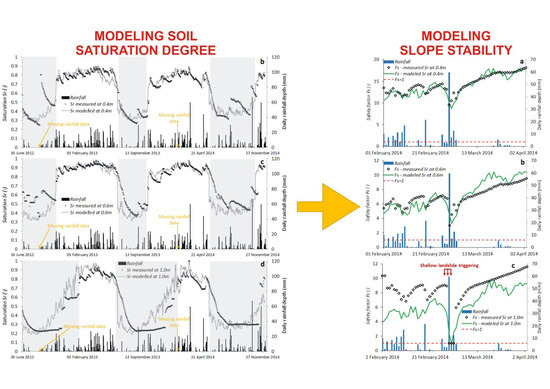A Simplified Approach to Assess the Soil Saturation Degree and Stability of a Representative Slope Affected by Shallow Landslides in Oltrepò Pavese (Italy)
Abstract
1. Introduction
- a)
- To calibrate and validate, on a site-specific scale, a simplified empirical model able to assess the degree of the soil saturation on the basis of readily available data, such as air temperature and rainfall;
- b)
- To validate, on a site-specific scale, a slope stability model that assumes thedegree of the soil saturation as the input data in order to evaluate the capability of the model to extendovera wide area; and
- c)
- To investigate the possibility of assessing the safety factor of a slope, only on the basis of readily available data, by coupling the two models validated with respect to (a) and (b).
2. Materials and Methods
2.1. TestSite Slope Geological Setting and Landslide Distribution
2.2. Soil Characterization at the TestSite Slope
2.3. Monitoring Equipment
2.4. Modeling the Degree of the Soil Saturation
2.5. Modeling the Slope Stability
3. Results and Discussions
3.1. Comparison between the Measured and Modeled Values of the Degree of the Soil Saturation
3.2. Slope Safety Factor Trends
4. Conclusions
Author Contributions
Funding
Acknowledgments
Conflicts of Interest
References
- Corominas, J.; Van Westen, C.; Frattini, P.; Cascini, L.; Malet, J.P.; Fotopoulou, S.; Catani, F.; Van DenEeckhaut, M.; Mavrouli, O.; Agliardi, F.; et al. Recommendations for the quantitative analysis of landslide risk. Bul. Eng. Geol. Environ. 2014, 73, 209–263. [Google Scholar] [CrossRef]
- Baum, R.; Savage, W.Z.; Godt, J.W. TRIGRS—A FORTRAN Program for Transient Rainfall Infiltration and Grid-Based Regional Slope-Stability Analysis, Version 2.0, US Geological Survey Open-File 15 Report 2008–1159. Available online: https://pubs.usgs.gov/of/2008/1159/ (accessed on 9 November 2018).
- Springman, S.M.; Thielen, A.; Kienzler, P.; Friedel, S. A long-term field study for the investigation of rainfall-induced landslides. Geotechnique 2013, 14, 1177–1193. [Google Scholar] [CrossRef]
- Ray, R.L.; Jacobs, J.M. Relationships among remotely sensed soil moisture, precipitation and landslide events. Nat. Hazards 2007, 43, 211–222. [Google Scholar] [CrossRef]
- Lu, N.; Godt, J.W. Infinite slope stability under steady unsaturated seepage conditions. Water Resour. Res. 2008, 44, W11404. [Google Scholar] [CrossRef]
- Montrasio, L.; Valentino, R. A model for triggering mechanisms of shallow landslides. Nat. Hazards Earth Syst. Sci. 2008, 8, 1149–1159. [Google Scholar] [CrossRef]
- Montrasio, L.; Valentino, R.; Corina, A.; Rossi, L.; Rudari, R. A prototype system for space-time assessment of rainfall-induced shallow landslides in Italy. Nat. Hazards 2014, 74, 1263–1290. [Google Scholar] [CrossRef]
- Ponziani, F.; Pandolfo, C.; Stelluti, M.; Berni, N.; Brocca, L.; Moramarco, T. Assessment of rainfall thresholds and soil moisture modeling for operational hydrogeological risk prevention in the Umbria region (central Italy). Landslides 2012, 9, 229–237. [Google Scholar] [CrossRef]
- Simunek, J.; Van Genucthen, M.T.; Sejna, M. Development and applications of the HYDRUS and STANMOD software packages and related codes. Vadose Zone J. 2008, 7, 587–600. [Google Scholar] [CrossRef]
- Granberg, G.; Grip, H.; Löfvenius, M.O.; Sundh, I.; Svensson, B.H.; Nilsson, M. A simple model for simulation of water content, soil frost, and soil temperatures in Boreal mixed mires. Water Resour. Res. 1999, 35, 3771–3782. [Google Scholar] [CrossRef]
- Brocca, L.; Melone, F.; Moramarco, T. On the estimation of antecedent wetness conditions in rainfall–runoff modelling. Hydrol. Proc. 2008, 22, 629–642. [Google Scholar] [CrossRef]
- Valentino, R.; Meisina, C.; Montrasio, L.; Losi, G.L. Predictive power evaluation of a physically based model for shallow landslides in the area of Oltrepò Pavese, Northern Italy. Geotech. Geol. Eng. 2014, 32, 783–805. [Google Scholar] [CrossRef]
- Brocca, L.; Ponziani, F.; Moramarco, T.; Melone, F.; Berni, N.; Wagner, W. Improving landslide forecasting using ASCAT-Derived soil moisture data: A case study of the Torgiovannetto landslide in Central Italy. Remote Sens. 2012, 4, 1232–1244. [Google Scholar] [CrossRef]
- Ray, R.L.; Jacobs, J.M.; Ballestero, T.P. Regional landslide susceptibility: spatiotemporal variations under dynamic soil moisture conditions. Nat. Hazards 2011, 59, 1317–1337. [Google Scholar] [CrossRef]
- Mittelbach, H.; Seneviratne, S.I. A new perspective on the spatio-temporal variability of soil moisture: temporal dynamics versus time-invariant contributions. Hydrol. Earth Syst. Sci. 2012, 16, 2169–2179. [Google Scholar] [CrossRef]
- Godt, J.W.; Baum, R.L.; Lu, N. Landsliding in partially saturated materials. Geophys. Res. Lett. 2009, 36, L02403. [Google Scholar] [CrossRef]
- Bittelli, M.; Valentino, R.; Salvatorelli, F.; Pisa, P.R. Monitoringsoil-water and displacement conditions leading to landslide occurrence in partially saturated clays. Geomorphology 2012, 173, 161–173. [Google Scholar] [CrossRef]
- Smethurst, J.A.; Clarke, D.; Powrie, D. Factors controlling the seasonal variation in soil water content and pore water pressures within a lightly vegetated clay slope. Geotechnique 2012, 62, 429–446. [Google Scholar] [CrossRef]
- Leung, A.K.; Ng, C.W.W. Seasonal movement and groundwater flow mechanism in an unsaturated saprolitic hillslope. Landslides 2013, 10, 455–467. [Google Scholar] [CrossRef]
- Bittelli, M.; Tomei, F.; Pistocchi, A.; Flury, M.; Boll, J.; Brooks, E.S.; Antolini, G. Development and testing of a physically based, three-dimensional model of surface and subsurface hydrology. Adv. Water Resour. 2010, 33, 106–122. [Google Scholar] [CrossRef]
- Valentino, R.; Montrasio, L.; Losi, G.L.; Bittelli, M. An empirical model for the evaluation of the degree of saturation of shallow soils in relation to rainfalls. Can. Geotech. J. 2011, 48, 795–809. [Google Scholar] [CrossRef]
- Zizioli, D.; Meisina, C.; Valentino, R.; Montrasio, L. Comparison between different approaches to modelling shallow landslide susceptibility: a case history in Oltrepò Pavese, Northern Italy. Nat. Hazards Earth Syst. Sci. 2013, 13, 559–573. [Google Scholar] [CrossRef]
- Zizioli, D.; Meisina, C.; Bordoni, M.; Zucca, F. Rainfall-triggered shallow landslides mapping through Pleiades images. In Landslide Science for a Safer Geoenvironment; Springer International Publishing: Heidelberg, Germany, 2014; Volume 2, pp. 325–329. [Google Scholar]
- Bordoni, M.; Meisina, C.; Valentino, R.; Lu, N.; Bittelli, M.; Chersich, S. Hydrological factors affecting rainfall-induced shallow landslides: from the field monitoring to a simplified slope stability analysis. Eng. Geol. 2015, 193, 19–37. [Google Scholar] [CrossRef]
- IUSS Working Group WRB. World Reference for Soil Resources 2006, First Update 2007; World Soil Resources Reports 103; The Food and Agriculture Organization (FAO): Rome, Italy, 2007. [Google Scholar]
- Baumhardt, R.L.; Lascano, R.J. Physical and hydraulic properties of a calcic horizon. Soil Sci. 1993, 155, 368–375. [Google Scholar] [CrossRef]
- Van Genuchten, M.T. A closed-form equation for predicting the hydraulic conductivity of unsaturated soils. Soil Sci. Soc. Am. J. 1980, 44, 892–898. [Google Scholar] [CrossRef]
- Peters, A.; Durner, W. Simplified evaporation method for determining soil hydraulic properties. J. Hydrol. 2008, 356, 147–162. [Google Scholar] [CrossRef]
- Rawlins, S.L.; Campbell, G.S. Water potential: Thermocouple Psychrometry. In Methods of Soil Analysis Part 1-Physical and Mineralogical Methods, 2nd ed.; American Society of Agronomy: Madison, WI, USA, 1986; pp. 597–618. [Google Scholar]
- Mualem, Y. A new model predicting the hydraulic conductivity of unsaturated porous media. Water Resour. Res. 1976, 12, 513–522. [Google Scholar] [CrossRef]
- Marquardt, D.W. An algorithm for least-squares estimation of non-linear parameters. J. Soc. Ind. App. Math. 1963, 11, 431–441. [Google Scholar] [CrossRef]
- Bordoni, M.; Bittelli, M.; Valentino, R.; Chersich, S.; Meisina, C. Improving the estimation of complete field soil water characteristic curves through field monitoring data. J. Hydrol. 2017, 552, 283–305. [Google Scholar] [CrossRef]
- Cuomo, S.; Della Sala, M. Rainfall-induced infiltration, runoff and failure in steep unsaturated shallow soil deposits. Eng. Geol. 2013, 162, 118–127. [Google Scholar] [CrossRef]
- Lanni, C.; McDonnell, J.; Hopp, L.; Rigon, R. Simulated effect of soil depth and bedrock topography on near-surface hydrologic response and slope stability. Earth Surf. Proc. Land. 2013, 38, 146–159. [Google Scholar] [CrossRef]
- Shao, W.; Bogaard, T.A.; Bakker, M.; Greco, R. Quantification of the influence of preferential flow on slope stability using a numerical modelling approach. Hydrol. Earth Syst. Sci. 2015, 19, 2197–2212. [Google Scholar] [CrossRef]
- Cascini, L.; Sorbino, G.; Cuomo, S.; Ferlisi, S. Seasonal effects of rainfall on the shallow pyroclastic deposits of the Campania region (southern Italy). Landslides 2014, 11, 779–792. [Google Scholar] [CrossRef]
- Lu, N.; Godt, J.W.; Wu, D.T. A closed-form equation for effective stress in unsaturated soil. Water Resour. Res. 2010, 46. [Google Scholar] [CrossRef]
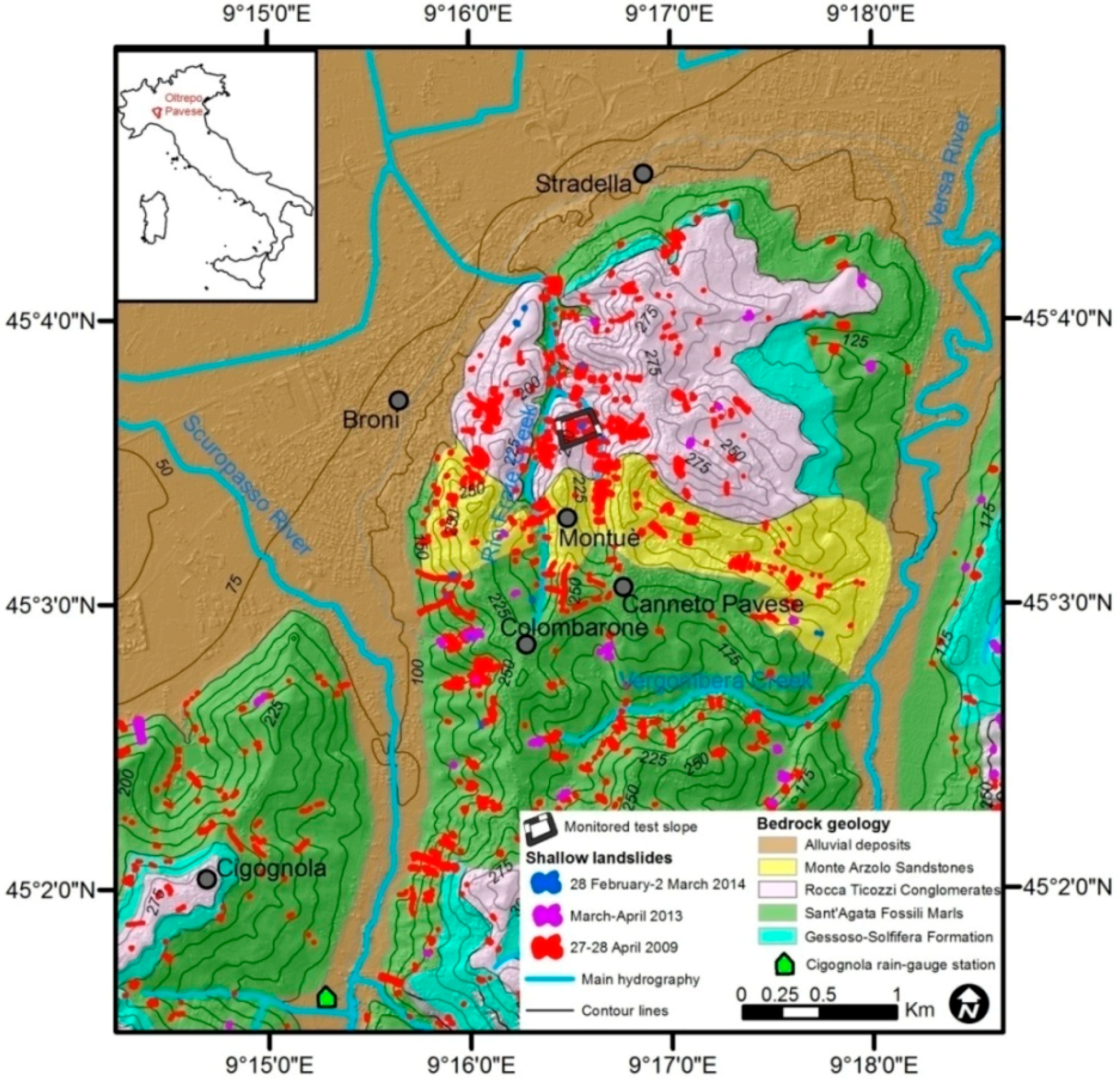


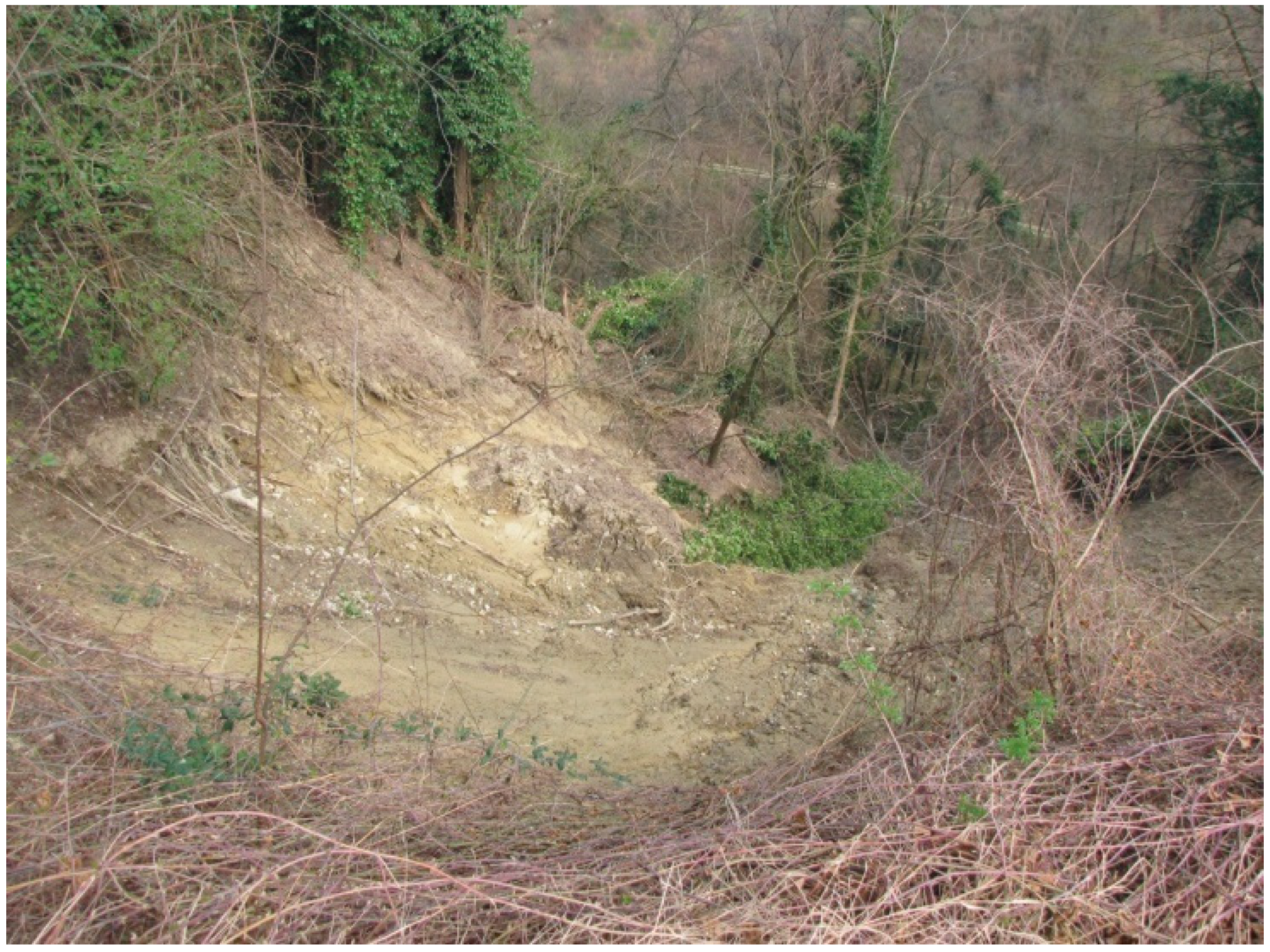

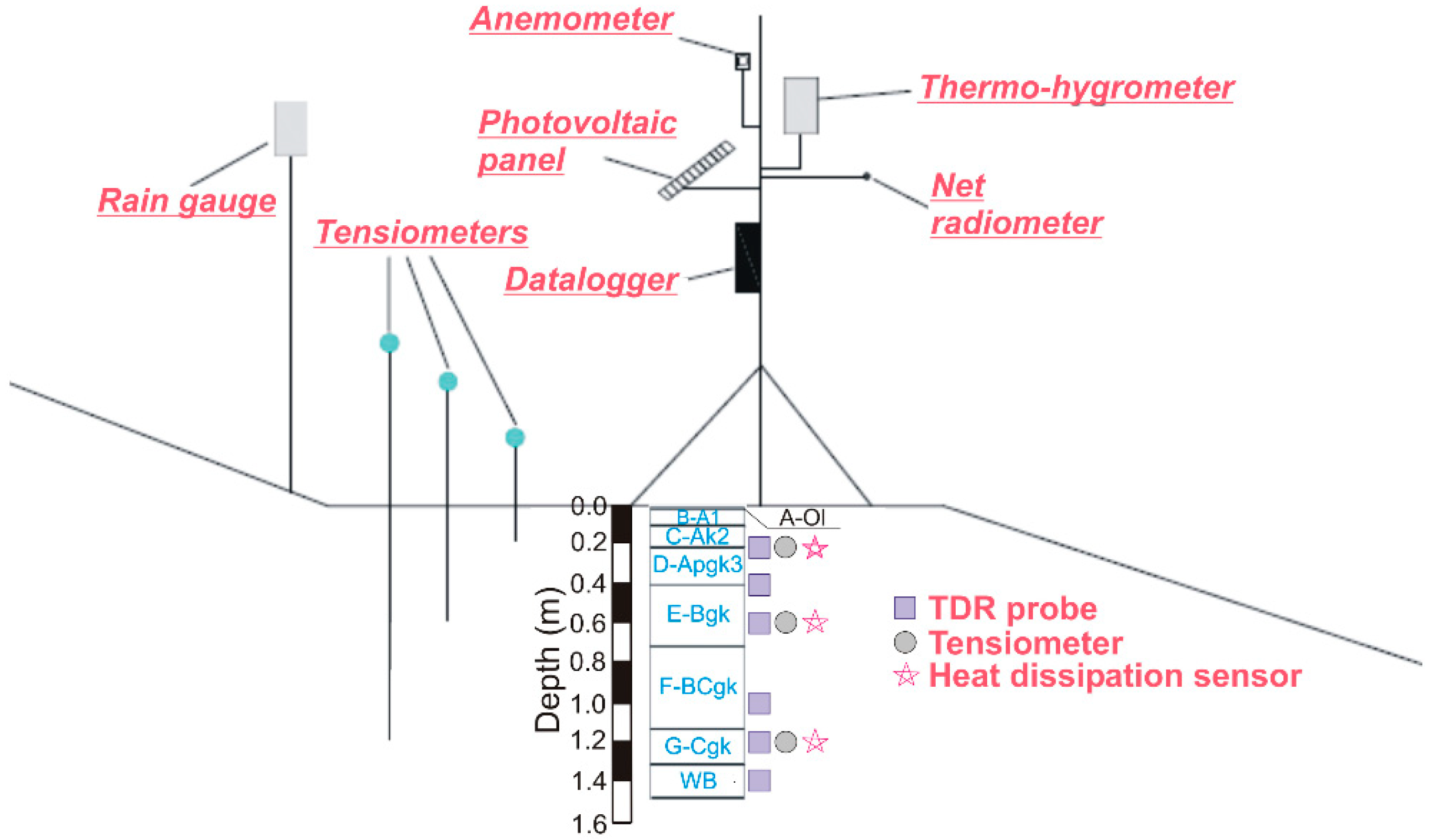
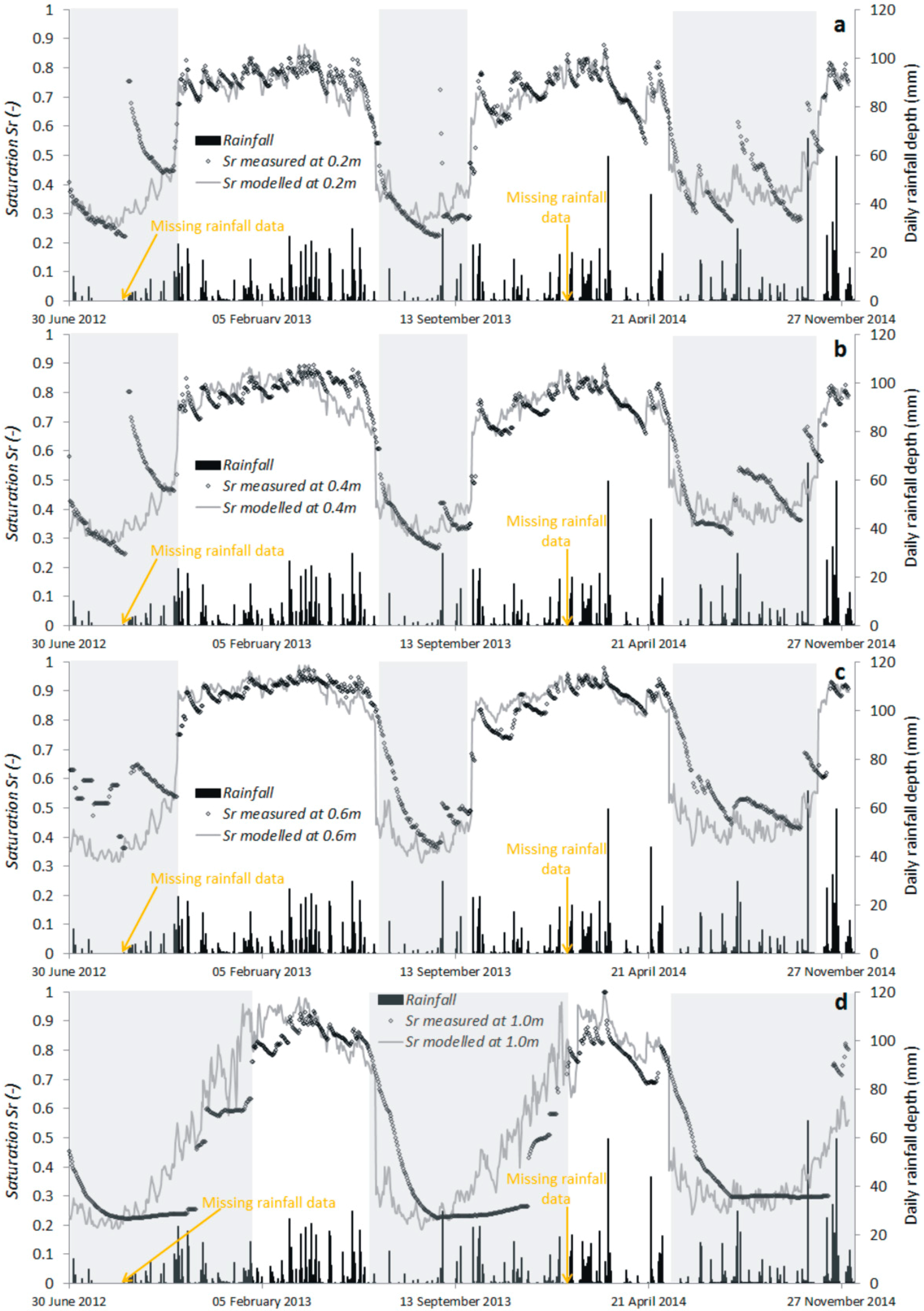
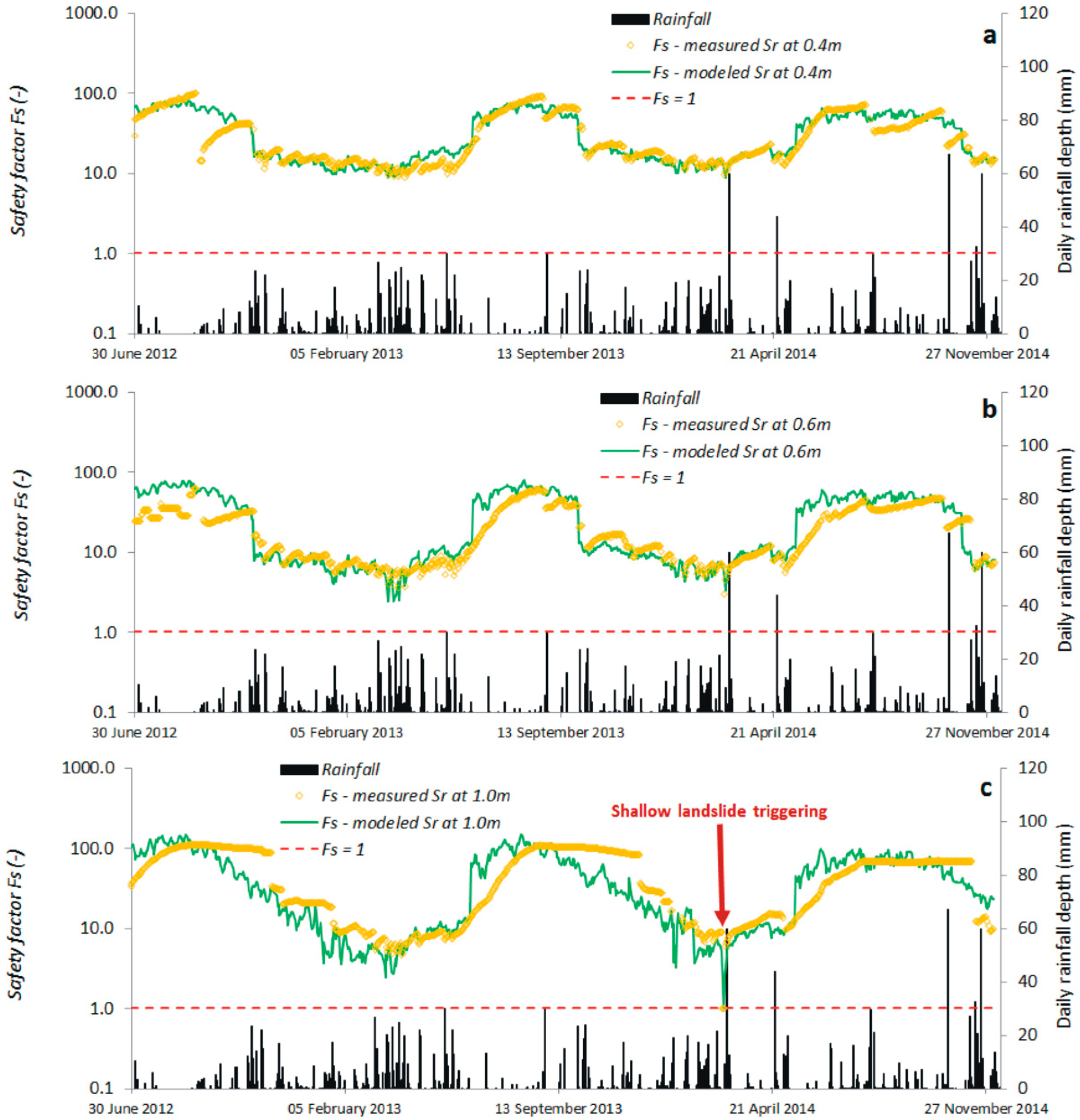
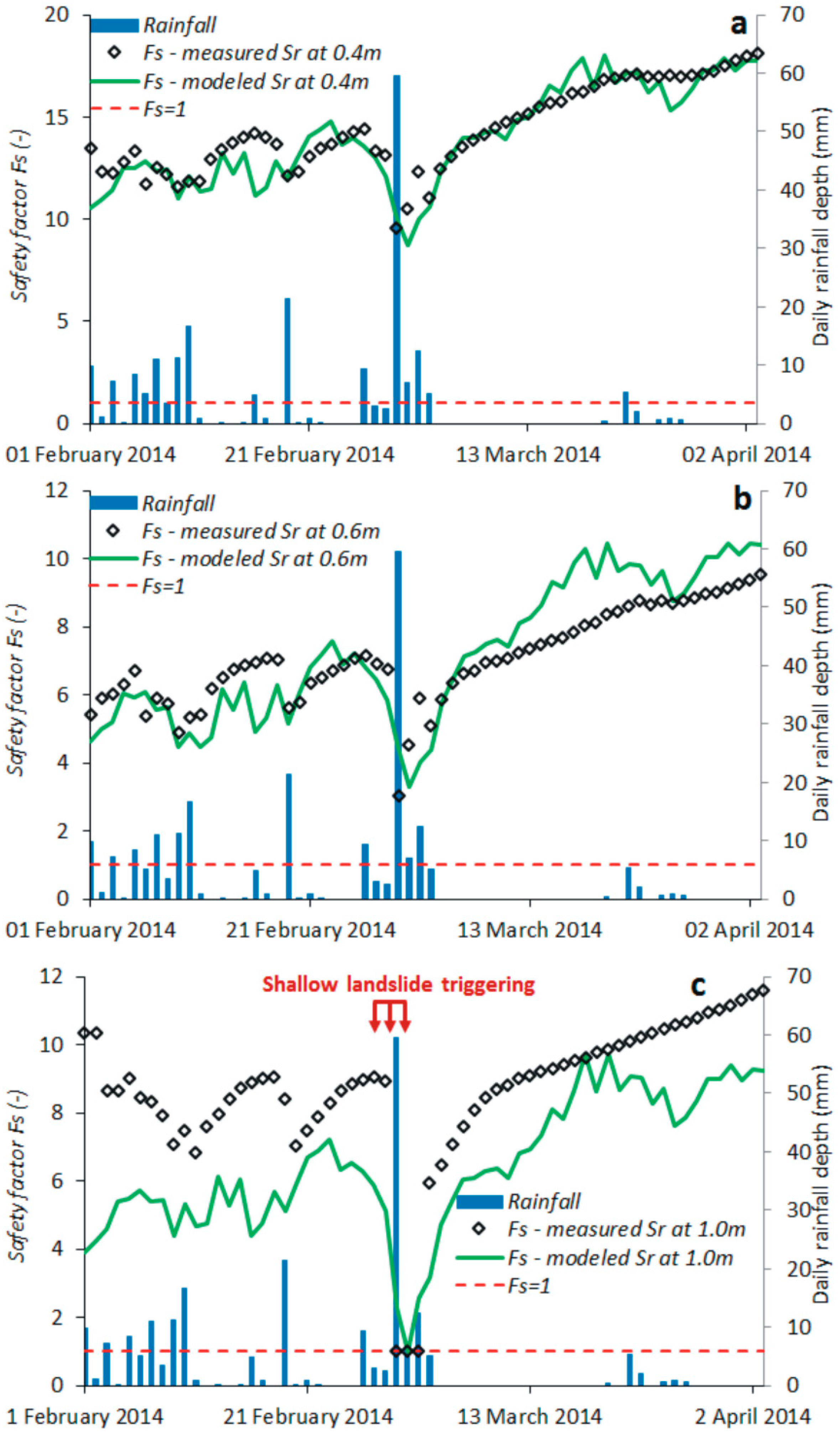
| Soil Horizon | Representative Depth | Gravel | Sand | Silt | Clay | wL | PI | USCSClass | γ | φ’ | c’ |
|---|---|---|---|---|---|---|---|---|---|---|---|
| m | % | % | % | % | % | % | kN/m3 | ° | kPa | ||
| A | 0.01 | 12.3 | 12.5 | 53.9 | 21.3 | 39.8 | 17.2 | CL | 17.0 | 31 | 0.0 |
| B | 0.1 | ||||||||||
| C | 0.2 | ||||||||||
| D | 0.4 | 1.6 | 11.0 | 59.5 | 27.9 | 38.5 | 14.3 | CL | 16.7 | 31 | 0.0 |
| E | 0.6 | 8.5 | 13.2 | 51.1 | 27.2 | 40.3 | 15.7 | CL | 16.7 | 31 | 0.0 |
| F | 1.0 | 2.4 | 12.2 | 56.4 | 29.0 | 39.2 | 15.9 | CL | 18.6 | 33 | 0.0 |
| G | 1.2 | 0.5 | 7.5 | 65.6 | 26.4 | 41.8 | 16.5 | CL | 18.2 | 26 | 29.0 |
| WB | 1.4 | 0.2 | 75.0 | 24.8 | 0.0 | - | - | SM | 18.1 |
| Soil Horizon | Representative Depth | α | µ | θs | θr | Ks |
|---|---|---|---|---|---|---|
| m | kPa−1 | - | m3m−3 | m3m−3 | ms−1 | |
| C | 0.2 | 0.013 | 1.43 | 0.43 | 0.03 | 2.5 × 10−6 |
| D | 0.4 | 0.013 | 1.43 | 0.43 | 0.03 | 2.5 × 10−6 |
| E | 0.6 | 0.010 | 1.40 | 0.42 | 0.01 | 1.5 × 10−6 |
| F | 1.0 | 0.009 | 1.38 | 0.39 | 0.02 | 1.0 × 10−6 |
| G | 1.2 | 0.007 | 1.34 | 0.40 | 0.01 | 5.0 × 10−7 |
| WB | 1.4 | 0.050 | 1.15 | 0.40 | 0.01 | 3.0 × 10−7 |
| Soil Horizon | Depth m | Field-Measured Sr | Input Parameters for Sr Model | |||||
|---|---|---|---|---|---|---|---|---|
| θs | θr | Sr(in) | β* | ξ | ψ (Wet Season) | ψ (Dry Season) | ||
| m3m−3 | m3m−3 | - | - | day−1 | °C−1 | °C−1 | ||
| C | 0.2 | 0.43 | 0.03 | 0.75 | 0.20 | 0.08 | 0.015 | 0.04 |
| D | 0.4 | 0.43 | 0.03 | 0.85 | 0.20 | 0.08 | 0.015 | 0.04 |
| E | 0.6 | 0.42 | 0.01 | 0.92 | 0.35 | 0.08 | 0.009 | 0.04 |
| F | 1.0 | 0.39 | 0.02 | 0.94 | 0.40 | 0.08 | 0.015 | 0.06 |
| Soil Horizon | Dry Season | |
|---|---|---|
| From | To | |
| C, D, E | 30 June 2012  15 June 2013  15 May 2014  | 31 October 2012 1 October 2013 31 October 2014 |
| F | 30 June 2012  15 June 2013  15 May 2014  | 30 January 2013 30 January 2014 5 December 2014 |
| Soil Horizon | Depth m | δ | Sr | γ | φ′ | c′ |
|---|---|---|---|---|---|---|
| ° | - | kN/m3 | ° | kPa | ||
| C | 0.2 | 30.2 | Field measured— Modeled through the model of Valentino et al. [21] | 17.0 | 31.0 | 0.0 |
| D | 0.4 | Field measured— Modeled through the model ofValentino et al. [21] | 16.7 | 31.0 | 0.0 | |
| E | 0.6 | Field measured— Modeled through the model ofValentino et al. [21] | 16.7 | 31.0 | 0.0 | |
| F | 1.0 | Field measured— Modeled through the model ofValentino et al. [21] | 18.6 | 33.0 | 0.0 |
| Soil Horizon | Depth m | RMSE | ||
|---|---|---|---|---|
| All Records | Dry Season | Wet Season | ||
| C | 0.2 | 0.07 | 0.10 | 0.05 |
| D | 0.4 | 0.08 | 0.11 | 0.06 |
| E | 0.6 | 0.11 | 0.16 | 0.06 |
| F | 1.0 | 0.14 | 0.15 | 0.09 |
© 2018 by the authors. Licensee MDPI, Basel, Switzerland. This article is an open access article distributed under the terms and conditions of the Creative Commons Attribution (CC BY) license (http://creativecommons.org/licenses/by/4.0/).
Share and Cite
Bordoni, M.; Valentino, R.; Meisina, C.; Bittelli, M.; Chersich, S. A Simplified Approach to Assess the Soil Saturation Degree and Stability of a Representative Slope Affected by Shallow Landslides in Oltrepò Pavese (Italy). Geosciences 2018, 8, 472. https://doi.org/10.3390/geosciences8120472
Bordoni M, Valentino R, Meisina C, Bittelli M, Chersich S. A Simplified Approach to Assess the Soil Saturation Degree and Stability of a Representative Slope Affected by Shallow Landslides in Oltrepò Pavese (Italy). Geosciences. 2018; 8(12):472. https://doi.org/10.3390/geosciences8120472
Chicago/Turabian StyleBordoni, Massimiliano, Roberto Valentino, Claudia Meisina, Marco Bittelli, and Silvia Chersich. 2018. "A Simplified Approach to Assess the Soil Saturation Degree and Stability of a Representative Slope Affected by Shallow Landslides in Oltrepò Pavese (Italy)" Geosciences 8, no. 12: 472. https://doi.org/10.3390/geosciences8120472
APA StyleBordoni, M., Valentino, R., Meisina, C., Bittelli, M., & Chersich, S. (2018). A Simplified Approach to Assess the Soil Saturation Degree and Stability of a Representative Slope Affected by Shallow Landslides in Oltrepò Pavese (Italy). Geosciences, 8(12), 472. https://doi.org/10.3390/geosciences8120472







